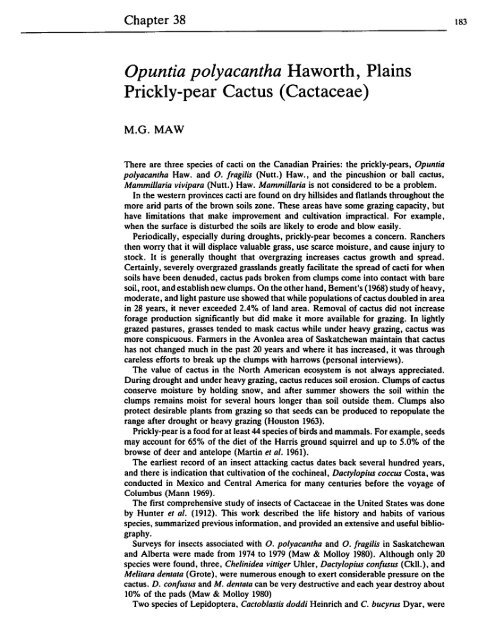pdf, 57.71Mb - Entomological Society of Canada
pdf, 57.71Mb - Entomological Society of Canada
pdf, 57.71Mb - Entomological Society of Canada
You also want an ePaper? Increase the reach of your titles
YUMPU automatically turns print PDFs into web optimized ePapers that Google loves.
Chapter 38<br />
Opuntia polyacantha Haworth, Plains<br />
Prickly-pear Cactus (Cactaceae)<br />
M.G. MAW<br />
There are three species <strong>of</strong> cacti on the Canadian Prairies: the prickly-pears, Opuntia<br />
polyacantha Haw. and O. tragi/is (Nutt.) Haw., and the pincushion or ball cactus,<br />
Mammillaria vivipara (Nutt.) Haw. Mammillaria is not considered to be a problem.<br />
In the western provinces cacti are found on dry hillsides and flatlands throughout the<br />
more arid parts <strong>of</strong> the brown soils zone. These areas have some grazing capacity, but<br />
have limitations that make improvement and cultivation impractical. For example,<br />
when the surface is disturbed the soils are likely to erode and blow easily.<br />
Periodically, especially during droughts, prickly-pear becomes a concern. Ranchers<br />
then worry that it will displace valuable grass, use scarce moisture, and cause injury to<br />
stock. It is generally thought that overgrazing increases cactus growth and spread.<br />
Certainly, severely overgrazed grasslands greatly facilitate the spread <strong>of</strong> cacti for when<br />
soils have been denuded, cactus pads broken from clumps come into contact with bare<br />
soil, root, and establish new clumps. On the other hand, Bement's (1968) study <strong>of</strong> heavy,<br />
moderate, and light pasture use showed that while populations <strong>of</strong> cactus doubled in area<br />
in 28 years, it never exceeded 2.4% <strong>of</strong> land area. Removal <strong>of</strong> cactus did not increase<br />
forage production significantly but did make it more available for grazing. In lightly<br />
grazed pastures, grasses tended to mask cactus while under heavy grazing, cactus was<br />
more conspicuous. Farmers in the Avonlea area <strong>of</strong> Saskatchewan maintain that cactus<br />
has not changed much in the past 20 years and where it has increased, it was through<br />
careless efforts to break up the clumps with harrows (personal interviews).<br />
The value <strong>of</strong> cactus in the North American ecosystem is not always appreciated.<br />
During drought and under heavy grazing, cactus reduces soil erosion. Clumps <strong>of</strong> cactus<br />
conserve moisture by holding snow, and after summer showers the soil within the<br />
clumps remains moist for several hours longer than soil outside them. Clumps also<br />
protect desirable plants from grazing so that seeds can be produced to repopulate the<br />
range after drought or heavy grazing (Houston 1963).<br />
Prickly-pear is a food for at least 44 species <strong>of</strong> birds and mammals. For example, seeds<br />
may account for 65% <strong>of</strong> the diet <strong>of</strong> the Harris ground squirrel and up to 5.0% <strong>of</strong> the<br />
browse <strong>of</strong> deer and antelope (Martin et al. 1961).<br />
The earliest record <strong>of</strong> an insect attacking cactus dates back several hundred years,<br />
and there is indication that cultivation <strong>of</strong> the cochineal, Dactylopius coccus Costa, was<br />
conducted in Mexico and Central America for many centuries before the voyage <strong>of</strong><br />
Columbus (Mann 1969).<br />
The first comprehensive study <strong>of</strong> insects <strong>of</strong> Cactaceae in the United States was done<br />
by Hunter et al. (1912). This work described the life history and habits <strong>of</strong> various<br />
species, summarized previous information. and provided an extensive and useful bibliography.<br />
Surveys for insects associated with O. polyacantha and O. /ragilis in Saskatchewan<br />
and Alberta were made from 1974 to 1979 (Maw & Molloy 1980). Although only 20<br />
species were found. three, Chelinidea vittiger Uhler, Dacty/opius con/usus (Ckll.), and<br />
Melitara dentata (Grote), were numerous enough to exert considerable pressure on the<br />
cactus. D. con/usus and M. dentala can be very destructive and each year destroy about<br />
10% <strong>of</strong> the pads (Maw & Molloy 1980)<br />
Two species <strong>of</strong> Lepidoptera. Cactob/aslis doddi Heinrich and C. bucyrus Dyar. were<br />
183
















